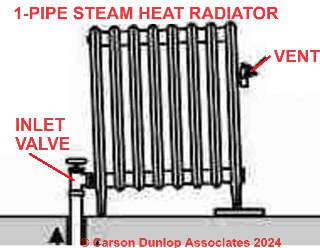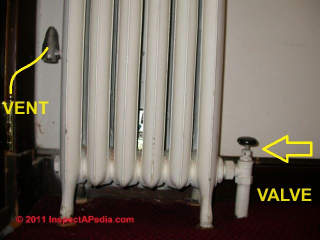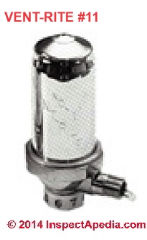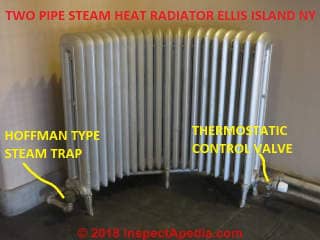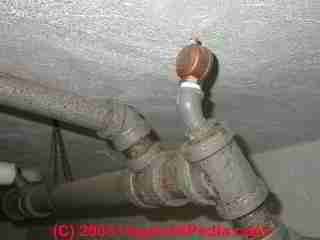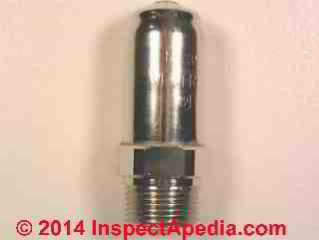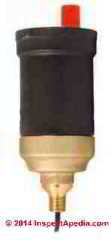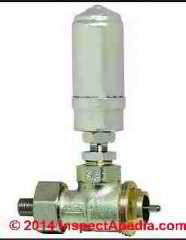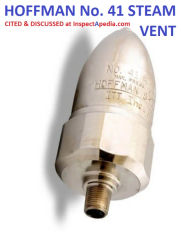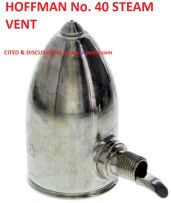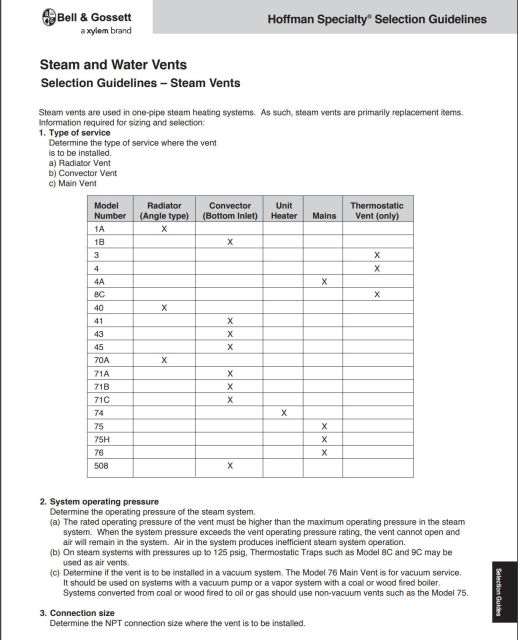 Steam Vent Types & Selection
Steam Vent Types & Selection
Which steam vents are used where on 1 pipe or 2 pipe steam heating systems?
- POST a QUESTION or COMMENT about steam vent selection and installation; guides to steam vent models, features, choices, applications, manufacturers, sources
Steam vent types:
Two-pipe steam heat vents vs one-pipe steam heat vents: this article describes the different types of vents used on two pipe and one pipe steam heating systems and explains why a 2 pipe steam heat system will generally require different vents at different locations from a 1 pipe system.
InspectAPedia tolerates no conflicts of interest. We have no relationship with advertisers, products, or services discussed at this website.
- Daniel Friedman, Publisher/Editor/Author - See WHO ARE WE?
Steam Vent Types, Applications, Choices & Selections
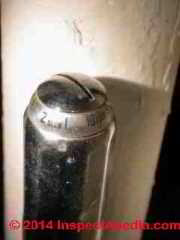 At left is the top of an adjustable steam vent. By adjusting between fast and slow you can regulate how quickly this steam radiator gets hot.
At left is the top of an adjustable steam vent. By adjusting between fast and slow you can regulate how quickly this steam radiator gets hot.
Steam radiator vents are found principally on one pipe steam heat radiators.
Here we discuss the requirements, installation, and troubleshooting of steam vents on radiators as well as other steam vents found on steam piping and at other locations in steam heating systems for both one pipe and two pipe steam systems
Watch out: If the radiator continually makes noises (whistling or wheezing) at the steam vent, there is a problem that needs to be fixed: a bad steam vent, steam piping problem, steam pressure set too high, or boiler oversized for the heating distribution system.
Watch out: Be sure your steam heating system and its controls are properly adjusted - excessive steam pressure can be dangerous.
[Click to enlarge any image]
Which Type of Steam Vent Should I Install?
Basically steam heating system heat up radiators by sending steam up riser pipes into the radiators. Vents at different locations depending on the steam heating system type (1-pipe vs. 2 pipe) let air out of the steam pipes and/or radiators so that steam can enter those heating devices.
In a one pipe system just one pipe feeds each steam heat radiator, as in the photo we show above, courtesy of Carson Dunlop Associates. As steam enters the radiator, air escapes at a radiator-mounted steam vent.
If your heating system is a 1-pipe steam heat system
see ONE PIPE STEAM HEAT VENTING - summarized just below
In a two pipe steam heat system two pipes are found connected at each steam heat radiator. Steam enters the radiator through one pipe and air and condensate exit at the other through a special steam trap or control as illustrated below.
Carson Dunlop Associates is a home inspection, report writing tool & education company in Toronto. (C) Illustrations used with permission.
If your heating system is a 2-pipe steam heat system
see STEAM VENTS, 2-PIPE SYSTEMS - described further below
We also provide a separate
STEAM VENT TABLE, CROSS REFERENCE & SOURCES
Air Vents on 1-Pipe Steam Radiators
Above our photo illustrates a 1 pipe steam system with a typical radiator vent.
Details about 1 pipe steam heat radiator venting are
at RADIATOR STEAM VENTS, 1-PIPE SYSTEMS. Just below on this page is a brief summary:
- Thermostatically-controlled no-float steam vents
THERMOSTATICALLY-CONTROLLED
Shown above: a Vent-Rite # 11 steam vent intended for 1 pipe steam systems.
- Float-type steam vents:
an water+alcohol filled float inside the steam vent heats, rises, and closes the vent as the radiator heats. The float also rises to prevent water from spitting out of the vent should condensate rise inside the radiator or vent.
On FLOAT-TYPE STEAM VENTS (as well as most others) rust or sediment can clog the float vent opening and interfere with its proper operation. Excessive steam pressure can also prevent the vent from operating properly.
The Vent-Rite #1 (or #11) shown above is designed for 1-pipe steam systems and mounts on the radiator. The company describes their #1 vent as providing ... quick, uniform distribution of heat to all radiation ...
This requires balancing the radiation by controlled venting.Vent-Rite #1 Non-Vacuum vents are adjustable and all vents are designed for positive action and straight-line venting. They function automatically to vent the air. If, through an unusual condition the vent is filed with water, the vent port automatically closes.
The Vent-Rite #1 Air Elimination Valve VentRite No 1 for Steam Radiators ... has been designed to eliminate air in any one pipe steam radiator system as quickly as possible to assure rapid ad efficient heating.
It will open and close all pressures up to 3 PSI Do not use at system pressure above 10 PsI This air valve is easily installed its [sic] standard 1/8" male connection makes it interchangeable with practically any other valve. It is fully adjustable, enabling the user to balance a system with a minimum of effort.
Use for free standing radiators, one pipe steam radiator system. (Adjustable angle vent). - Adjustable steam vents
operate similarly to the float-type steam vents described above, but add the feature
of ADJUSTABLE AIR VENTS allow varying the air vent opening size so that the air venting rate can be better matched to the radiator size. (Larger steam radiators need a larger air vent opening.)
Examples of adjustable steam vents include: Hoffman Model 1A (Part No. 401422) adjustable air valve with 6 settings (1-slow to 6-fast venting); VariValve® Quick-Vent. Those vents are designed for traditional steam radiators. If your steam heat is by a steam convector unit, different steam vents are required, such as the Hoffman Specialty Model 1B (Part No. 401425). - Adjustable-Thermostatically-operated steam vents
ADJUSTABLE THERMOSTATICALLY OPERATED include an adjustable room temperature thermostat that allows the occupant to set the desired room temperature.
Setting this thermostatically operated steam vent control actually adjusts the rate at which the vent permits air to escape from the individual radiator, similar to the adjustable steam vents described above, but in this case once the thermostat is set, the automatically regulating steam vent is responding to the room temperature setting.
...
Vents for 2-Pipe Steam Radiator Systems
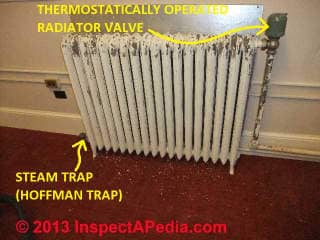 A two pipe steam system carries steam up and condensate back in different pipes, using a thermostatic trap at the end of each radiator to discharge both air and water from the radiator.
A two pipe steam system carries steam up and condensate back in different pipes, using a thermostatic trap at the end of each radiator to discharge both air and water from the radiator.
Our photo shows a 2-pipe steam heat radiator; one pipe feeds steam at the top right end of the radiator, controlled by a thermostatically operated inlet valve, while at the left side of the radiator at its bottom condensate returns to the boiler through a Hoffman steam trap.
Simple texts like Weil McLain's study course simply state
Do not use air vents on two pipe steam heat systems" Instead yo use float and thermostatic (F&T) traps at the end of the system main. These are fast-acting traps that allow both air and condensate out of the system main.
The Vent-Rite #35,75, or 77 are intended for main vents (two pipe systems and located on the mains); The Vent-Rite #31 & 33 are used on steam risers and on steam convectors. Contact the company for help or to download their product guide.
The Honeywell Braukmann V110F, for example, is used on both hot water and two-pipe steam systems to provide individual radiator heat control (by thermostatic operation).
Some two pipe steam systems also include a vacuum breaker in the mains.
That device allows air into the system when the system cools down after the boiler has shut off.
Above is an unusual curved two pipe steam radiator at which both connections are at the radiator's bottom, inlet at the right, outlet at the left.
A thermoststatic control valve at the radiator's right end (white knob) controls the steam input into the radiator - closeup below:
A Hoffman steam trap a 2-pipe steam radiator's outlet end (photo below) allows condensate to return to the steam boiler.
Details about steam traps are
at STEAM TRAPS
Are There Air Vents for 2-Pipe Steam Heating Systems?
In a two pipe system air escapes via the Hoffman steam trap (photograph above) or similar device at the radiator base (on the condensate return side of the radiator), as well as from vents along the main piping (photo below).
While you won't see steam vents on two-pipe steam heat radiators, there may indeed be different models of air vents on the main steam pipe risers in the 2-pipe steam heating system in your building.
Simple texts like Weil McLain's study course simply state
Do not use air vents on two pipe steam heat systems" Instead you use float and thermostatic (F&T) traps at the end of the system main. These are fast-acting traps that allow both air and condensate out of the system main.
Other Main Vents, Hoffman Steam Traps & Vacuum Breakers Used on 2-Pipe Steam Heating Systems
Vent-Rite Steam Vents for 2-Pipe Systems
- Vent-Rite Valve Corporation: 1875 Dewey Ave. Benton Harbor, MI 49022 TEL: (269) 925-8818 FAX: (269) 925-7888. Vent-rite advises: For venting basement mains use the Vent-Rite 35, 75, or 77 air valve or an equivalent from another manufacturer.
- The Vent-Rite #31 & 33 are used on steam risers and on steam convectors.
- The Vent-Rite #35 (shown at left), Vent-Rite No. 75, or Vent-Rite steam vent No. 77 are intended for main vents (two pipe systems and located on the mains). The Vent-Rite No. 35 shown in our photo is distributed on EBay by Barnes & Jones, Inc.
You will probably also find a Hoffman trap at the two pipe steam radiator outlet (below left) and one or more main steam line vents (photo below right).
Some two pipe steam systems also include a vacuum breaker in the main as well. That device allows air into the system when the system cools down after the boiler has shut off.
Basically, to work at all, steam systems have to let air in and out of the piping system. Air enters when the system cools (the burner is off) and air is forced out by rising steam when the system heats (burner is on and making steam).
Rising steam works with air vents to allow steam into and air out of radiators during the heating phase. During the cooling phase air enters the system at vacuum breaking vents, air vents, and possibly at valve stems and other locations.
Honeywell Braukmann automatic valves on steam systems?
The Braukmann automatic valve you cite as present on your system is a Honeywell product, though I don't know which product you found installed.
The Honeywell Braukmann EA122A1002 Automatic Air Vent shown above (if that's what you've got) is intended to vent air from high pressure mains and equipment in hot or cold water systems - this is a hydronic systems valve not a steam vent.
However we might find a hydronic (hot water heat) system air vent installed on a steam system in which a lower floor in the building is being heated by hot water from the boiler rather than by steam.
The company does produce thermostatic radiator valves that might be found on a steam or hot water heating system and also a Honeywell V2042HSL10 steam radiator valve used on one pipe steam systems and shown just below.
If yours is a two pipe steam system I would not expect you to find this valve installed.
If you can give me a photo or identifying markings I will explain further; most likely it's there to purge air from the steam main. Quoting:
Continuing: Mike, I suspect that the old vent you removed was a mistake from the get go; it might have worked, somewhat, as it's a versatile valve, but that's not what the literature says works properly.
The Braukmann auto valve is a Honeywell product; if you can give me a photo or identifying markings on your Honeywell Braukmann I will explain further; most likely it's there to vent the steam main.
Or if you are talking about a radiator valve, the Honeywell Braukmann V110F, for example, is used on both hot water and two-pipe steam systems to provide individual radiator heat control (by thermostatic operation).
Contact
- Vent-Rite Valve Corporation: 1875 Dewey Ave. Benton Harbor, MI 49022 TEL: (269) 925-8818
- Emerson Swan, Inc., 300 Pond Street, Randolph, MA 02368, Tel: (781) 986-2000 Fax: (781) 986-2028, info@emersonswan.com - Emerson Swan is a nationally recognized, stocking manufacturer’s representative organization serving the northeastern United States and the Greater Toronto Area.
For steam vent troubleshooting also see STEAM VENTS where we discuss other steam vent problems such as cold radiators, banging pipes, noisy radiators, steam vents that spitting water, clogging steam vents, and steam vent replacement.
...
Summary of Types of Steam Vents on 1 & 2 Pipe Steam Systems
The Table of Non-Vacuum Vents & Their Applications & Substitution Part Numbers
and the
Steam Vent Cross Reference / Substitution Chart are now
at STEAM VENT TABLE & CROSS REFERENCES
...
Reader Comments, Questions & Answers About The Article Above
Below you will find questions and answers previously posted on this page at its page bottom reader comment box.
Reader Q&A - also see RECOMMENDED ARTICLES & FAQs
On 2020-02-27 by Anonymous - What is the difference between Hoffman No. 40 or No. 41 steam vent?
What is the diference between 40 or 41 valve
On 2020-02-28 - by (mod) - Mounting location difference between the Hoffman No. 40 and Hoffman No. 41 Steam Vents?
Both the No. 40 and No. 41 are steam vents found on the steam distribution system such as radiators and convectors. The main difference is in how each vent is mounted and thus where it is intended for use.
- The Hoffman No. 41 is a steam vent that mounts vertically and is normally used on convector steam heaters.
- The Hoffman No. 40 is a steam vent that mounts with a right-angle fitting normally found on the side of steam radiators.
Hoffman No. 41 Steam Vent details
Hoffman Model 41 Part No. 401455, 1/8" Straight Steam Convector Air Valve (Non-vacuum)
Telescopic siphon tube with angle cut assures drainage
1/8" NPT straight shank
Maximum operating pressure 6 psig (0.4 bar)
Drop away pressure - maximum pressure against which the vent can open
Maximum pressure 10 psig (0.7 bar)
Shown above is the Hoffman NO. 41 steam ventHoffman No. 40 Steam Vent Details
Hoffman Steam Air Vent 40, 1/8" Angle Steam Radiator Air Valve 401440
Air Valve (non-vacuum)
Float-type vent
Single non-adjustable port
1/8" NPT angle connection
Maximum operating pressure 6 psig (0.4 bar)
This vent is shown just aboveAlso see this Hoffman Steam Vent Selection Guide from p. 133 of the Hoffman Specialty General Catalog HS-900G available from Hoffman or at this website https://inspectapedia.com/heat/Hoffman-Specialty-Catalog-HS-900G.pdf
[Click to enlarge any image]
Also see the companion Hoffman Specialty Service Parts Catalog and contact information for Hoffman given in the article above on this page.
On 2020-02-02 by Mary - How do I adjust a Dole steam vent?
Almost all my radiators have Dole adjustable steam vents like the one you have pictured below the headline "Steam Vent Types, Applications etc." This winter my bedroom radiator has decided not to work.
How do I adjust the steam vent? I've never had a problem with my radiators before so I want to make certain I do this correctly.
On 2020-02-02 - by (mod) - Dole type steam vent operation & adjustment
Mary the Dole type steam vent in our photo has a slot on the vent top that permits use of a thin coin or a wide-bladed screwdriver to turn the top adjustment to a setting between "1 = slow" and "10 = fast" - setting to a higher number will vent air faster and the steam radiator should heat more-rapidly.
However if your steam vent isn't venting at all it may need to be replaced.
Watch out: I do not recommend even trying to replace the steam vent unless
1. the steam radiator control knob can be closed - and has been set to its closed (clockwise) position
or
2. the building's steam heat is OFF and will be left off long enough to unscrew the old and screw in the new steam vent
and
3. you have a replacement steam vent at hand, ready to install
My concern is that if the building steam is "up" and you remove the vent entirely you can get scalded by steam blowing out of the steam vent mounting opening.
On 2017-11-24 by Trn - here is a report on flow tests done for steam vents
For everybody who wants to figure out settings across brands of vents, look for an online PDF by Gerry Gill and Steve Pajek.
They did flow rate tests and they have a chart that tells you exactly what each setting does in cubic feet per minute so you can compare with a different manufacturer.
On 2017-11-25 by (mod) - flow rate in CFM of air or air/steam mix being vented from specific steam vents
Thanks TRN, for taking the time to add the suggestion about steam venting data provided by Gill and Pajek.
Readers will want to note that the flow rate in CFM of air or air/steam mix being vented from specific steam vents at individual radiators in their homes will vary from both theory and from the factory numbers for specific models of steam vents for a number of reasons such as the exact pressure in their particular team system, piping restrictions, formation of scale in the steam vent, etc.
In the field the truth of these variables in actual installed steam system sufficiently nettlesome that most installers use simple rules of thumb or simply buy and install steam vents with which they're familiar, perhaps changing out to a larger or smaller steam vent or an adjustable steam vent when they get complaints about individual rooms or radiators that are too hot, too cold, or too slow to warm up.
If whole areas of a building are heating too quickly or too slowly, the steam technician will be looking first not at individual steam radiator vents but at vents on the vertical main steam risers.
Still Gill and Pajek's 2005 study, commented-on by Dan Holohan (Mr. Steam), can be helpful if you are having trouble balancing the heat output from a steam system (across different steam radiators or in different rooms or areas in a building).You can find their paper currently at Dan Holohan's website:at heatinghelp.com/assets/documents/Balancing-Steam-Systems-Using-a-Vent-Capacity-Chart-1.pdf
On 2016-10-26 by Wayne - what's the best replacement Steam Vent?
I need to replace an 85 year old Hoffman No 16 vent valve on my home steam main (one of 4). The No 16 was for a vacuum system but my system is no longer operated as a vacuum system. A simple 1 pipe low pressure system. I have tried a Dole No 13 and it spouts water when the heat comes up in the AM. What is the best, American made replacement?
On 2015-11-25 by ed levy - what replacement steam vent should I buy?
hi there. quick question. i manage a 15 unit apartment building, 5 story. oil burner. approximately 4 small radiators per apartment. single pipe system ( i believe). my super is installing "maid-o-mist" ⅛" #4 vents on the radiators. there are 7 risers (on the top floor). what type vent and size vent should be installed there?
thanks
edmond
Moderator reply: choose the steam vent based on the radiator size, vent capacity, and need for adjustability
Above on this page we outline types of steam vents that depend on your need, and we give links to sources of the most popular steam vent brands and models and free PDF downloads. Each manufacturer will also have steam vent model recommendation charts, in those PDFs that you can match to your system and radiators.
But really the easiest way to choose a replacement steam vent is to buy the same type and model that was installed originally. I think that the original steam system installer has already done the analysis to choose the best vent in size or capacity.
The reason you might change from that original steam vent would be the need for added function such as thermostatic control - where you're getting too much heat in some areas and not enough in others.
On 2015-11-19 by Ed - Hoffman No.30 boiler return trap with no water in sight glass.
Have a Hoffman no.30 boiler return trap with no water in sight glass.
On 2015-11-19 by (mod) - trouble with no water in boiler
Ed
The problem could be the sight glass itself, butWatch out: to avoid destroying the boiler I would SHUT THE BOILER OFF IMMEDIATELY
then you will want to investigate further. Failure of return of condensate to the steam boiler is usually a condensate return line or condensate trap clog issue.See also SIGHT GLASS, STEAM BOILER
and LOW WATER CUTOFF VALVE, BOILER - to protect your boiler if in fact it doesn't have enough water to prevent an explosion or damage
On 2014-12-02 by Anbu Mahesh - is a vent mandatory on steam equipment?
In a steam condenser, vent is mandatory or not?
If vent is not provided, what will be problems occured during operation.
On 2014-12-02 by (mod) -
Anbu
If your radiators are unvented, particularly in a 1 pipe steam system designed to use steam vents, the result of no vents will be:
No heat
But as you'll read in this article series, some two pipe steam system radiators use other controls and won't have a steam vent.
...
Continue reading at STEAM VENTS, 1-PIPE SYSTEMS where we describe just about every type of automatic steam vent used on residential and most commercial systems. or select a topic from the closely-related articles below, or see the complete ARTICLE INDEX.
Or see these
Recommended Articles
- STEAM HEAT RADIATOR REPAIR
- RADIATOR VALVES & HEAT CONTROLS
- STEAM TRAPS
- STEAM VENTS - home
- UNEVEN HEAT DIAGNOSIS
Suggested citation for this web page
STEAM VENT TYPES, SELECTION at InspectApedia.com - online encyclopedia of building & environmental inspection, testing, diagnosis, repair, & problem prevention advice.
Or see this
INDEX to RELATED ARTICLES: ARTICLE INDEX to STEAM BOILERS
Or use the SEARCH BOX found below to Ask a Question or Search InspectApedia
Ask a Question or Search InspectApedia
Try the search box just below, or if you prefer, post a question or comment in the Comments box below and we will respond promptly.
Search the InspectApedia website
Note: appearance of your Comment below may be delayed: if your comment contains an image, photograph, web link, or text that looks to the software as if it might be a web link, your posting will appear after it has been approved by a moderator. Apologies for the delay.
Only one image can be added per comment but you can post as many comments, and therefore images, as you like.
You will not receive a notification when a response to your question has been posted.
Please bookmark this page to make it easy for you to check back for our response.
IF above you see "Comment Form is loading comments..." then COMMENT BOX - countable.ca / bawkbox.com IS NOT WORKING.
In any case you are welcome to send an email directly to us at InspectApedia.com at editor@inspectApedia.com
We'll reply to you directly. Please help us help you by noting, in your email, the URL of the InspectApedia page where you wanted to comment.
Citations & References
In addition to any citations in the article above, a full list is available on request.
- Honeywell Corporation, Tel: U.S. 1 (877) 841-2840, International 001 (480) 353-3020, Website: www.honeywell.com
- Vent-Rite Valve Corporation: 1875 Dewey Ave. Benton Harbor, MI 49022 TEL: (269) 925-8818 FAX: (269) 925-7888
- Emerson Swan, Inc. 300 Pond Street Randolph, MA 02368 Tel: (781) 986-2000 Fax: (781) 986-2028 info@emersonswan.com
- Barnes & Jones Corporation, 91 Pacella Park Drive Randolph, MA 02368, Tel: 781-963-8000calibrated steam traps and vents, Email: bnesbitt@barnesandjones.com. Vent-Rite steam vents for radiator control.
- Gorton Heating Corporation, 546 South Avenue East, Cranford, New Jersey 07016, Tel: 908-276-1323, email: info@gorton-valves.com, fast venting valves for steam heating systems.
- "Rv-4 One-Pipe Steam Radiator Valve", available from Armstrong International,
816 Maple Street, Three Rivers, MI 49093 USA, Tel: (269) 273-1415, Armstrong has offices in Beijing, China, Belgium, India and Mexico. Web search 12/27/2010, original source:
http://www.armstronginternational.com/thermostatic-valves-rv-4-one-pipe. - "Special Steam Vents", Hoffman Specialty heating products, web search 12/27/2010, original source:
http://www.hoffmanspecialty.com/pdf/hs900/HS900-3474.pdf - "Steam and Water Vents, Selection Guidelines - Steam Vents", Hoffman Specialty, web search 12/27/2010, original source:
http://www.hoffmanspecialty.com/pdf/hs900/HS900-stvents.pdf - Hoffman 1A adjustable steam vents, available from Hoffman Specialty, ITT, web search 12/27/2010, original source:
http://www.drillspot.com/products/51570/Hoffman_1A_Adjustable_Automatic_Air_Vent_For_Steam_Radiators - Hoffman Convector Steam Vents, available from Hoffman Specialty, ITT, web search 12/28/2010, original source:
http://www.hoffmanspecialty.com/pdf/hs900/HS900-conv109.pdf - Report 95-14, PB96-198163 Thermostatic Radiator Valve (TRV) Demonstration Project, contact NYSERDA. 17 Columbia Circle, Albany, NY 12203-6399 Toll-Free: 1-866-NYSERDA, Tel:(518)465-6252, Ext. 241. Web Search 12/27/2010, original source: http://www.homeenergy.org/archive/hem.dis.anl.gov/eehem/96/960509.html
- VariValve® Quick-Vent from Heat Timer, adjustable radiator and main line vent valves for one pipe steam systems, web search 12/27/2010, original source: http://www.heat-timer.com/enFiles/ProductDocument/literature/VariV056082C.pdf
- "Care & Feeding of Air Vents", Dan Holohan, Old House Journal Online, November 2004
- The Steam Book, 1984, Training and Education Department, Fluid Handling Division, ITT [probably out of print, possibly available from several home inspection supply companies] Fuel Oil and Oil Heat Magazine, October 1990, offers an update, (see next item in this list). ITT Fluid Technology,
1133 Westchester Avenue
White Plains, NY 10604, tel +1 914 304 1700 fax +1 914 696 2950 www.ittfluidbusiness.com - Principles of Steam Heating, $13.25 includes postage. Fuel oil & Oil Heat Magazine, 389 Passaic Ave., Fairfield, NJ 07004.
- The Lost Art of Steam Heating, Dan Holohan, 516-579-3046 FAX
- Principles of Steam Heating, Dan Holohan, technical editor of Fuel Oil and Oil Heat magazine, 389 Passaic Ave., Fairfield, NJ 07004 ($12.+1.25 postage/handling).
- "Residential Steam Heating Systems", Instructional Technologies Institute, Inc., 145 "D" Grassy Plain St., Bethel, CT 06801 800/227-1663 [home inspection training material] 1987
- The Heat Efficiency of Steam Boilers, Bryan Donkin
- Steam Boiler Operation, Principles & Practice, James J. Jackson
- The Steam Book, 1984, Training and Education Department, Fluid Handling Division, ITT [probably out of print, possibly available from several home inspection supply companies] Fuel Oil and Oil Heat Magazine, October 1990, offers an update,
- Principles of Steam Heating, $13.25 includes postage. Fuel oil & Oil Heat Magazine, 389 Passaic Ave., Fairfield, NJ 07004.
- The Lost Art of Steam Heating, Dan Holohan, 516-579-3046 FAX
- Principles of Steam Heating, Dan Holohan, technical editor of Fuel Oil and Oil Heat magazine, 389 Passaic Ave., Fairfield, NJ 07004 ($12.+1.25 postage/handling).
- "Residential Steam Heating Systems", Instructional Technologies Institute, Inc., 145 "D" Grassy Plain St., Bethel, CT 06801 800/227-1663 [home inspection training material] 1987
- Boilers, Boiler Conversions, James E. Brumbaugh, ISBN 0-672-23389-4 (v. 1) Volume II, Oil, Gas, and Coal Burners, Controls, Ducts, Piping, Valves, James E. Brumbaugh, ISBN 0-672-23390-7 (v. 2) Volume III, Radiant Heating, Water Heaters, Ventilation, Air Conditioning, Heat Pumps, Air Cleaners, James E. Brumbaugh, ISBN 0-672-23383-5 (v. 3) or ISBN 0-672-23380-0 (set) Special Sales Director, Macmillan Publishing Co., 866 Third Ave., New York, NY 10022. Macmillan Publishing Co., NY
- Our recommended books about building & mechanical systems design, inspection, problem diagnosis, and repair, and about indoor environment and IAQ testing, diagnosis, and cleanup are at the InspectAPedia Bookstore. Also see our Book Reviews - InspectAPedia.
- In addition to citations & references found in this article, see the research citations given at the end of the related articles found at our suggested
CONTINUE READING or RECOMMENDED ARTICLES.
- Carson, Dunlop & Associates Ltd., 120 Carlton Street Suite 407, Toronto ON M5A 4K2. Tel: (416) 964-9415 1-800-268-7070 Email: info@carsondunlop.com. Alan Carson is a past president of ASHI, the American Society of Home Inspectors.
Thanks to Alan Carson and Bob Dunlop, for permission for InspectAPedia to use text excerpts from The HOME REFERENCE BOOK - the Encyclopedia of Homes and to use illustrations from The ILLUSTRATED HOME .
Carson Dunlop Associates provides extensive home inspection education and report writing material. In gratitude we provide links to tsome Carson Dunlop Associates products and services.


